Identification, characterization and domestication of new sorghum (Sorghum bicolor L.) genotypes to saline environments of the Aral sea regions
Assessment of crop genetic resources is an efficient tool to generate new stress-tolerant varieties with high yield characteristics for harsh environments such as in the Aral Sea regions. Sorghum is a C4 grass capable of both high biomass and grain yields in semiarid and drier parts of the world. In this study, sixteen sorghum genotypes were assessed in terms of grain and biomass production under the saline aquifer of the Aral Sea region during the 2019-2021 growing seasons. The tested sorghum genotypes were planted as a split-plot design with three replicates in the experimental field. The highest plant height was found in SSV-84 (288 cm) and Kulzha (272 cm), indicating good adaptation features under the saline environment (moderately saline serosems soil; EC 8-10 dS m-1). A considerable difference was observed in the grain and biomass yield of the tested sorghum genotypes. The highest grain yield was produced by Kazakhstanskoe-16 (6970 kg ha-1) while the highest biomass yield was achieved by Orange-160 (57770 kg ha-1). The correlation analysis showed a weak interaction (r=0.524) between the grain yield and vegetation period parameters, implying a genetic specificity has an advantage of the agronomic performance. Lab experiments also confirmed the superiority of the selected genotypes over the local genotype in regards of seed germination and seedling growth. Based on the field and lab experiments, Kazakhstanskoe-16 and Orange-160 were found to be salt tolerant sorghum genotypes with high yield traits and recommended for further assessment to the State Varietal Commission of Agricultural Crops for large-scale use in salt-affected arid areas.
